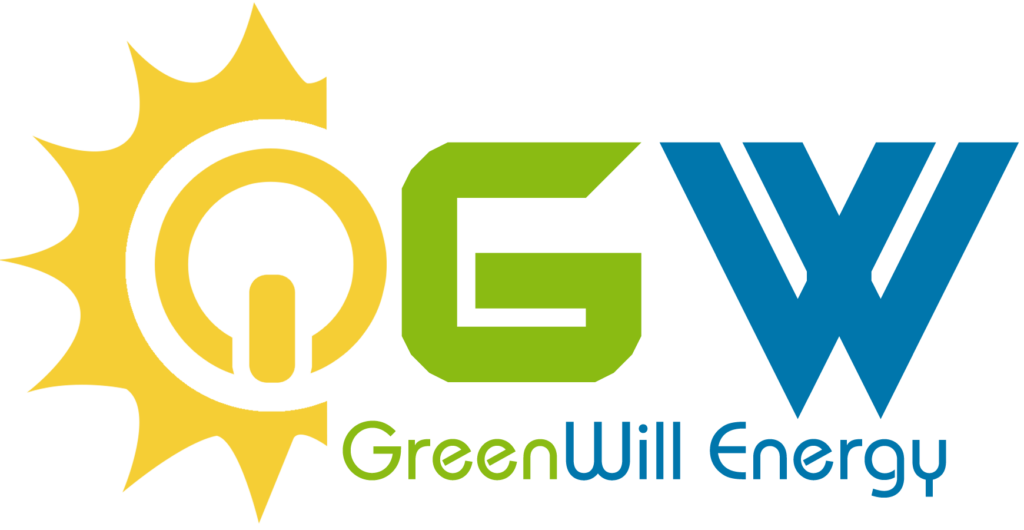Solar Inverter
Solar Inverter: Brian of Solar System
Photovoltaic inverter (PV inverter or solar inverter) can convert the variable DC voltage generated by photovoltaic solar panels into the mains frequency alternating current (AC) inverter, which can be fed back to the commercial transmission system, or the grid for off-grid use.
Photovoltaic inverter is one of the important balance of system (BOS) in photovoltaic array system, which can be used with general AC power supply equipment. Solar inverters have special functions for photovoltaic arrays, such as maximum power point tracking and island effect protection.
Inverters in the new energy industry are mainly used in the fields of photovoltaics and energy storage.
- The photovoltaic inverter is one of the main components of the photovoltaic power generation system. Connecting the photovoltaic array and the power grid is the key to ensure the long-term reliable operation of the photovoltaic power station.
- The energy storage inverter can control the charging and discharging process of the battery and perform AC-DC conversion.

In the entire photovoltaic system, although the photovoltaic inverter accounts for only 8%-10% of the total cost, it undertakes important functions such as AC-DC conversion, power control, and off-grid switching of the entire system, and is also responsible for the entire photovoltaic system. The intelligent control of the system plays the role of the brain, so the importance is self-evident.
Because the inverter is composed of power semiconductors, capacitors, inductors and other electronic components, its service life is generally about 10 years, but the average usable life of photovoltaic power plants is about 25 years, within the life of photovoltaic power plants, so inverters have Inventory replacement needs.
From the perspective of the grid side and the user side, it is necessary to develop accurate algorithms as software to cooperate with the operation and use of products.
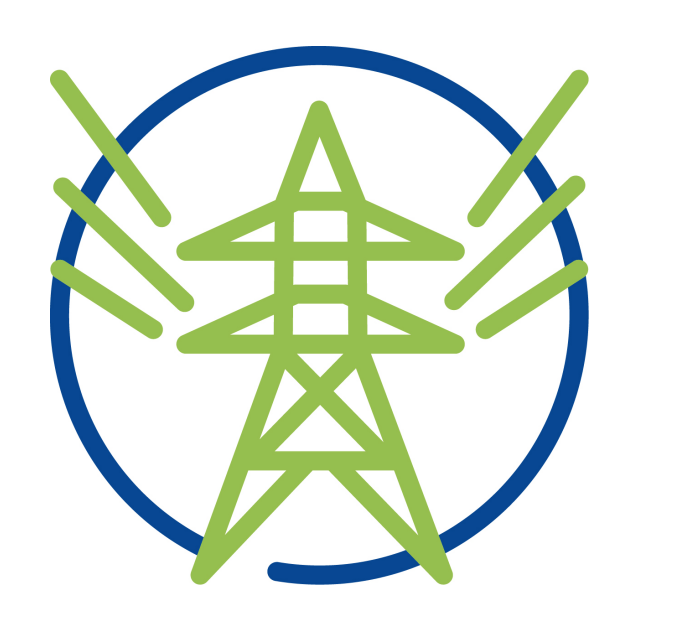
The application requirements of inverters gradually change from “self-protection, not affecting the grid” to “traveling through faults, adapting to the grid” and then to “adjusting active and reactive power, supporting the grid“.
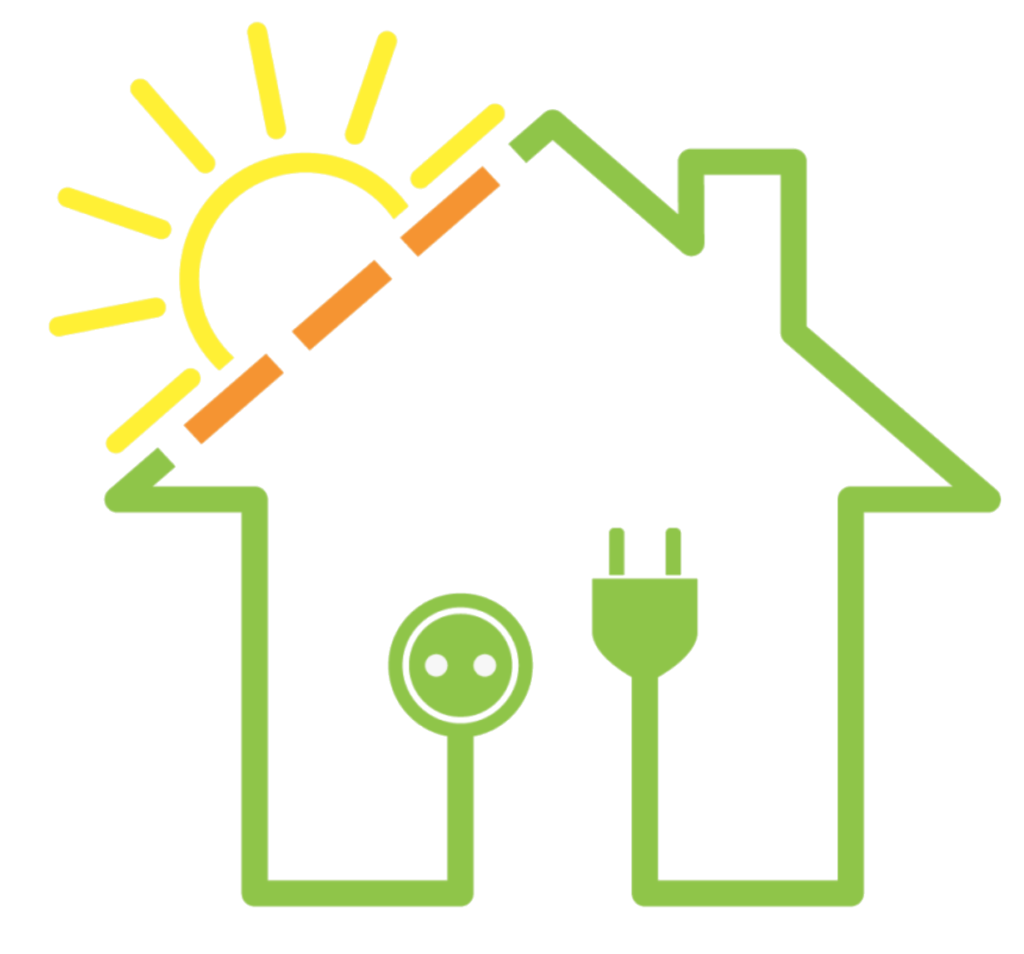
As the only smart device in the photovoltaic system that has multiple digital functions and is directly connected to the power grid, the inverter puts forward higher requirements for the intelligence of the inverter, and provides data support for the intelligent operation and maintenance of the power station.
The inverter not only has the function of DC-AC conversion, but also has the function as follows:
- Maximizing the performance of solar cells
- System fault protection
- Automatic operation and shutdown
- Maximum power point tracking (MPPT)
- For Grid-connect solar systems functions:
- Anti-solitary operation
- Automatic voltage adjustment
- DC detection & DC grounding detection
- The most important functions are the automatic operation and shutdown function and the maximum power point tracking control function(MPPT).
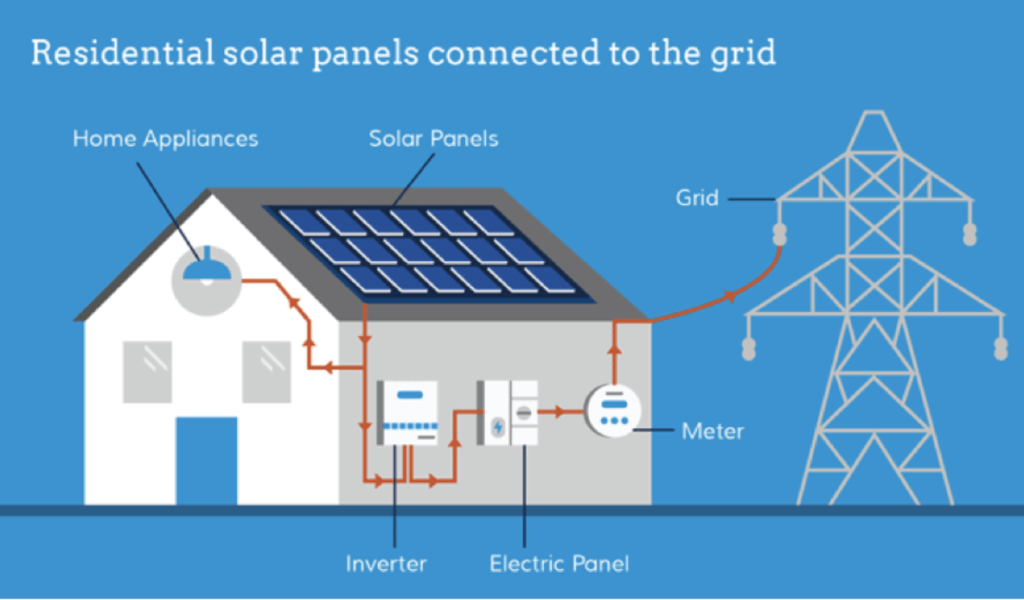


After sunrise in the morning, the intensity of solar radiation increases gradually, and the output of solar cells increases accordingly. When the output power required by the inverter is reached, the inverter starts to run automatically.
After entering the operation, the inverter will monitor the output of the solar cell components all the time, as long as the output power of the solar cell components is greater than the output power required by the inverter, the inverter will continue to run; until the sunset stops, even if it is rainy The inverter also works. When the output of the solar cell module becomes smaller and the output of the inverter is close to 0, the inverter will form a standby state.

The output of the solar cell module varies with the intensity of solar radiation and the temperature of the solar cell module itself (chip temperature).
In addition, because the solar cell module has the characteristic that the voltage decreases with the increase of the current, so there is an optimal operating point that can obtain the maximum power. The intensity of solar radiation is changing, obviously the best working point is also changing.


The purpose of maximum power point tracking is to sample the output of the solar cell and try to maintain the maximum power output under any environmental conditions. Maximum power point tracking equipment is generally integrated into power conversion equipment, including voltage or current conversion, filtering, and redriving loads such as grids, batteries, or motors.
Key Technology:MPPT
Photovoltaic solar systems may be connected to inverters, external grids, battery packs or other electronic loads. But no matter what kind of load it is connected to, the problems to be dealt with by MPPT are similar, that is, the efficiency of solar cell power transmission is related to the amount of sunlight hitting the solar panel, and also related to the electronic characteristics of the load.
When the sunshine situation changes, the load curve that can provide the maximum power transmission efficiency also changes accordingly. If the load can be adjusted to match the load curve with the highest power transmission efficiency, the system will have the best efficiency. The load characteristic at which power transfer is most efficient is called the maximum power point. The maximum power point tracking is to try to find the maximum power point and maintain the load characteristics at this power point. The power at the maximum power point (Pmpp) is the product of the maximum power point voltage (Vmpp) and current (Impp).
Solar Inverter Structure & Working Principle
Structure
Photovoltaic inverters, also known as solar converters and inverters, are a type of component that converts DC current into AC current. It consists of three parts: an inverter bridge, a logic control, and a filter circuit, including an input interface and a voltage operating circuit, PWM controller, DC conversion circuit, LC oscillation and output circuit, load and other parts. It can be divided into half-bridge inverter and full-bridge inverter.
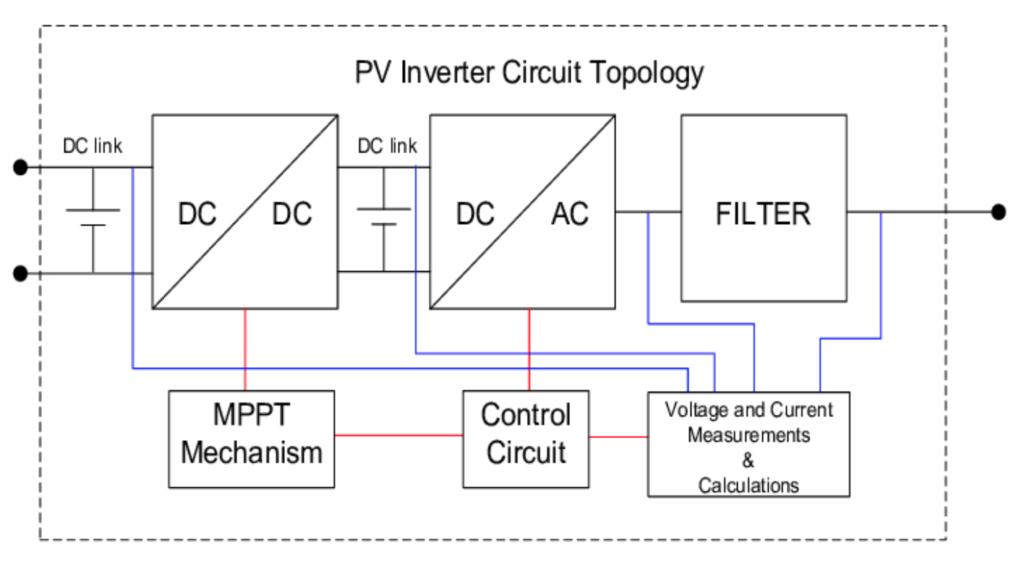
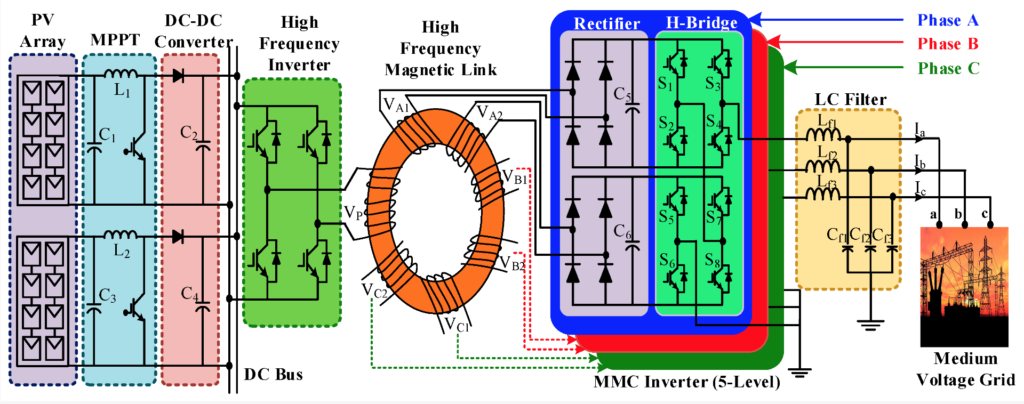
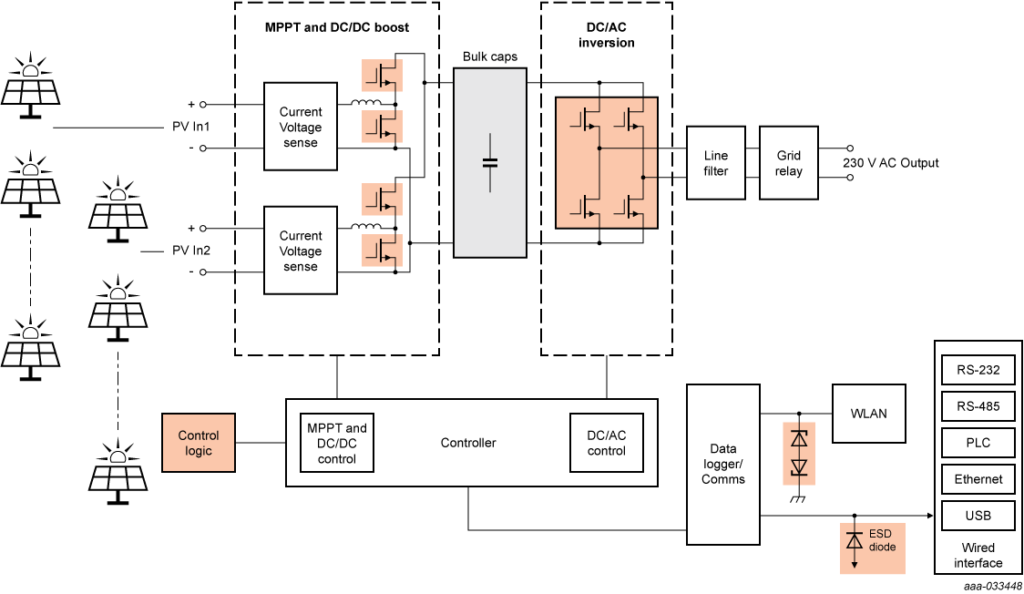
Working Principle
The working principle of the photovoltaic inverter is that the control system controls the operation of the entire system. The photovoltaic inverter circuit completes the function of converting DC current into AC current, and the filter circuit is used to filter unnecessary information. The work of the inverter circuit can also be optimized as follows:
Firstly, the oscillating circuit converts the DC current into an AC current.
In addition, the coil boost converts the irregular AC current into a square wave AC current.
Finally, the rectifier drives the AC current through the square wave Convert to sine wave alternating current.
Energy storage inverter
The energy storage inverter converts AC power into DC power and stores it in the battery. When a power outage occurs, the inverter converts the DC power in the battery into AC power for users to use, and can provide users with a balance between grid power and battery power. The two-way conversion between them can break through the limitation that the photovoltaic inverter can only be used during the day, which is one of the important reasons why it is becoming more and more popular among users.
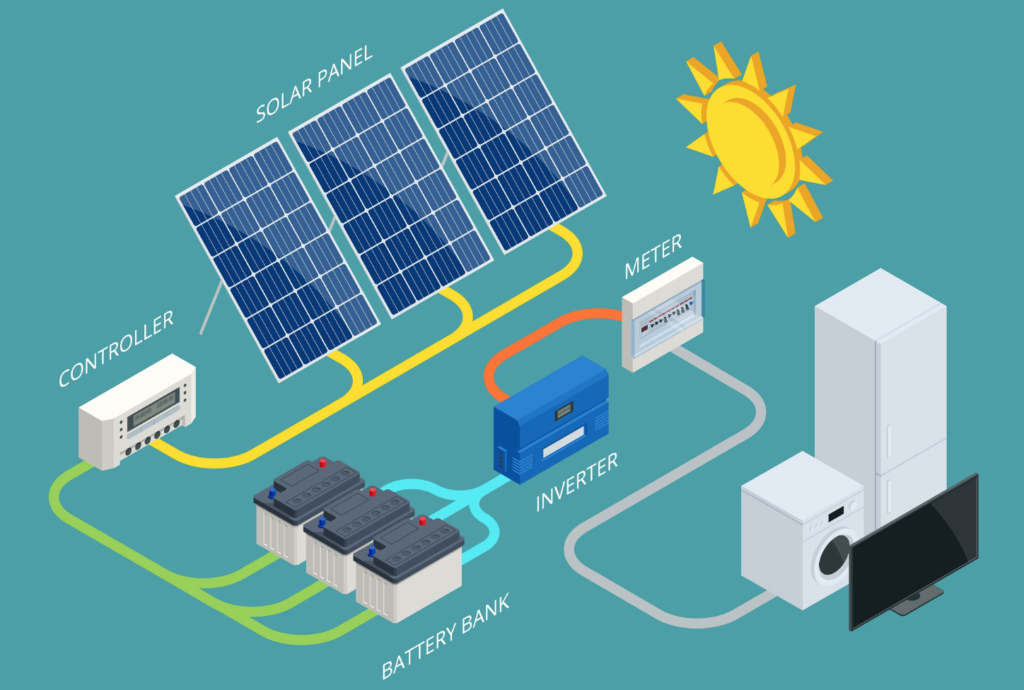
Why choose to install an energy storage inverter?
① Raise a higher proportion of self-use. During the day, the electricity generated by the photovoltaic is used by the load, and the excess electricity is stored in the battery; at night, the photovoltaic does not generate electricity, and the electricity from the battery is used by the load, so as to achieve the purpose of not using the grid or using less grid electricity.
② When the power grid fails or the grid is unstable, it can automatically switch to the battery-powered mode. This switching time is very short (UPS effect), and the load can continue to be used.
③ The effect of two-way energy storage – photovoltaics can charge the battery, and the same power grid can also charge the battery (when the electricity cost is low); in this way, the battery can be used to adjust the peak-valley electricity price difference or as a backup power supply.
④ It can also be used under pure off-grid conditions, driving loads with a certain power to work.
Types, Differences, Application & Brands
of Solar Inverters
| Item No. | Type | Feature | Applications | Power Range | Advantages | Disadvantages | Brands |
|---|---|---|---|---|---|---|---|
| GWE-CSI | Centralized Solar Inverter | The DC power generated by photovoltaic modules is aggregated into a larger DC power and then inverted. | Mainly used in centralized ground-based large-scale photovoltaic power plants with uniform sunlight | 250K-10MW | Large output power, mature technology, high power quality and low cost | The tracking accuracy of MPPT is not enough, and it occupies a large area. It needs a special computer room for ventilation and heat dissipation. The installation is not flexible, and the power consumption of itself and the ventilation and heat dissipation of the computer room are large. | SUNGROW, SINENG |
| GWE-SSI | String Solar Inverter | Several groups (generally 1-4 groups) of photovoltaic strings are individually tracked for maximum power peak value, and then merged into the AC grid after inversion. | Mainly used for household, small industrial and commercial distributed and ground power station | 1.5KW-250KW | Large number of MPPTs with high tracking accuracy, high power generation capacity, flexible component configuration, easy installation, and quick operation and maintenance |
(1) The electrical clearance of power devices is small, which is not suitable for high altitude areas; there are many components, integrated together, and the stability is slightly poor; (2) Outdoor installation, wind and sun can easily lead to aging of the shell and heat sink; (3) The number of inverters is large, the total failure rate will increase, and the system monitoring is difficult. |
GINLONG, GOODWE, GROWATT |
| GWE-DSI | Distributor Solar Inverter | Through multiple MPPT control optimizers in front, the multi-channel MPPT optimization function is realized, and the centralized inverter is used for inversion after confluence. | Mainly used in complex large-scale ground power stations | 1M-10MW | Centralized inverter, decentralized MPPT tracking, low cost, high reliability, high power generation | Less engineering experience, safety and stability need to be verified, large footprint, requires a dedicated computer room | SINENG, HOPEWIND |
| GWE-MSI | Micro Solar Inverter | Carry out individual maximum power peak tracking for each photovoltaic module, and then merge into the AC grid after inversion. | Mainly used for small power plants such as households | 200W-1500W | Perform independent maximum power tracking control for each module, improve overall efficiency and minimize safety hazards in the event of shading or module performance differences | High cost, difficult to maintain after failure | HOYMILES, APSYSTEM |
| Item No. | Type | Feature | Working Priciple | Applications | Advantages | Disadvantages |
|---|---|---|---|---|---|---|
| GWE-GSI | Grid Solar Inverter |
Grid-connected means that photovoltaic power generation is converted into AC through an inverter, connected to the grid through boosting or directly connected to the low-voltage side, and the grid dispatches and uses the electric energy. Grid-connected solar inverters are an important part of grid-connected power generation, usually can be divided into solar grid-connected inverters, wind power grid-connected inverters, electrical equipment grid-connected inverters and other power generation equipment grid-connected inverters. |
Many parallel photovoltaic strings are connected to the DC input end of the same centralized inverter. Usually, the ones with high power use three-phase igbt module power modules, and the ones with low power use field effect transistors. At the same time, DSP switching controllers are used. To improve the quality of the generated electric energy, making it very close to the sine wave current. |
In large power station systems |
1) Higher power generation efficiency and lower cost. 2) High output power quality. 3) Wide range of applications 4) High security and more reliable |
There is a threshold, and it needs to meet the relevant regulations and policies of the local power grid, otherwise it cannot provide grid connection. |
| GWE-OGSI | Off-grid Solar Inverter | The off-grid inverter is a system that is separated from the public grid. The direct current generated by the solar panel is first stored in the battery, and then the battery is transported to the off-grid inverter for inversion. The AC power can be directly supplied to the load. Used, can also be returned to battery storage. | Off-grid inverters typically employ a complete system approach of modular components, consisting of a number of regulated building blocks: solar inverter, controller, generation start module, and system control board. | It is more suitable for some areas without electric energy network coverage, such as desert areas, plateau areas, and forest areas, and can guarantee the needs of electric energy at any time | It can be used for energy storage and direct power supply, without connecting to the grid, or switching to the grid with load | Low efficiency, high electromagnetic interference, heavy weight, expensive For off-grid solar systems, batteries are mandatory |
| GWE-HBSI | Hybrid Solar Invert | Hybrid inverters cover high-tech technologies such as photovoltaic grid-connected technology, off-grid power generation technology, battery charging and discharging and energy storage technology, and power distribution technology. |
The hybrid inverter mainly has the functions of photovoltaic parallel and off-grid power generation. When the power supply of the grid is normal, the device closes the bypass relay to realize the power supply from the grid to the load of household appliances; when the power supply of the grid is abnormal, the device can supply power to the load of household appliances through the battery after inverter. |
It can play a very good role in areas without power supply networks such as pastoral areas, earthquake areas, and islands, and is especially suitable for occasions where the grid is unstable or the cost of grid power supply is high. | It can be used both off-grid and grid-connected, so the battery can be flexibly configured. | High cost (typically 20-30% higher than conventional inverters), heavy sales efforts, low customer awareness, and lack of standardization challenges, market adoption of dual-input home appliances remains limited. |
| Item No. | Type | Feature | Applications | Advantages | Disadvantages |
|---|---|---|---|---|---|
| GWE-1PSI | 1-Phase Solar Inverter |
1 single-phase solar inverter converts the output AC voltage into a single-phase, such as AC 220V or 230V. There are three jacks at the interface of the single-phase inverter: L: Red or brown wire for live wire (the logo letter is 'L'Live Wire) N: Zero wire (the logo letter is 'N'Null wire) with blue or white wire PE: The ground wire (the logo letter is 'E'Earth) with a yellow and green wire |
Systems less than 5KW generally adopt 1-Phase solar inverter grid connection | Simple, use less components | Greater loss, lower efficiency |
| GWE-3PSI | 3-Phase Solar Inverter |
3-phase solar inverter converts the AC voltage into three phases, namely AC380V. 3-phase electricity is composed of three AC potentials with the same frequency, equal amplitude, and 120° phase difference. The interface of the three-phase inverter has five holes, which are A, B, C, N, and PE in sequence. Phase A is yellow, phase B is green, phase C is red, N means the neutral line with blue or white, PE means the ground line with yellow and green. |
It is mainly used in the uninterruptible power supply system of communication, factory and enterprise. More than 5KW generally adopts 3-Phase grid-connected system |
1) Higher output voltage can drive more powerful appliances. 2) Better voltage level and higher safety. 3) The instantaneous power is more stable. 4) The higher the voltage used, the cheaper the electricity bill. In other words, at the same cost, the power transmission capacity of the three-phase inverter is stronger than that of the single-phase inverter. |
Higher cost and more complicated maintenance |
| Item |
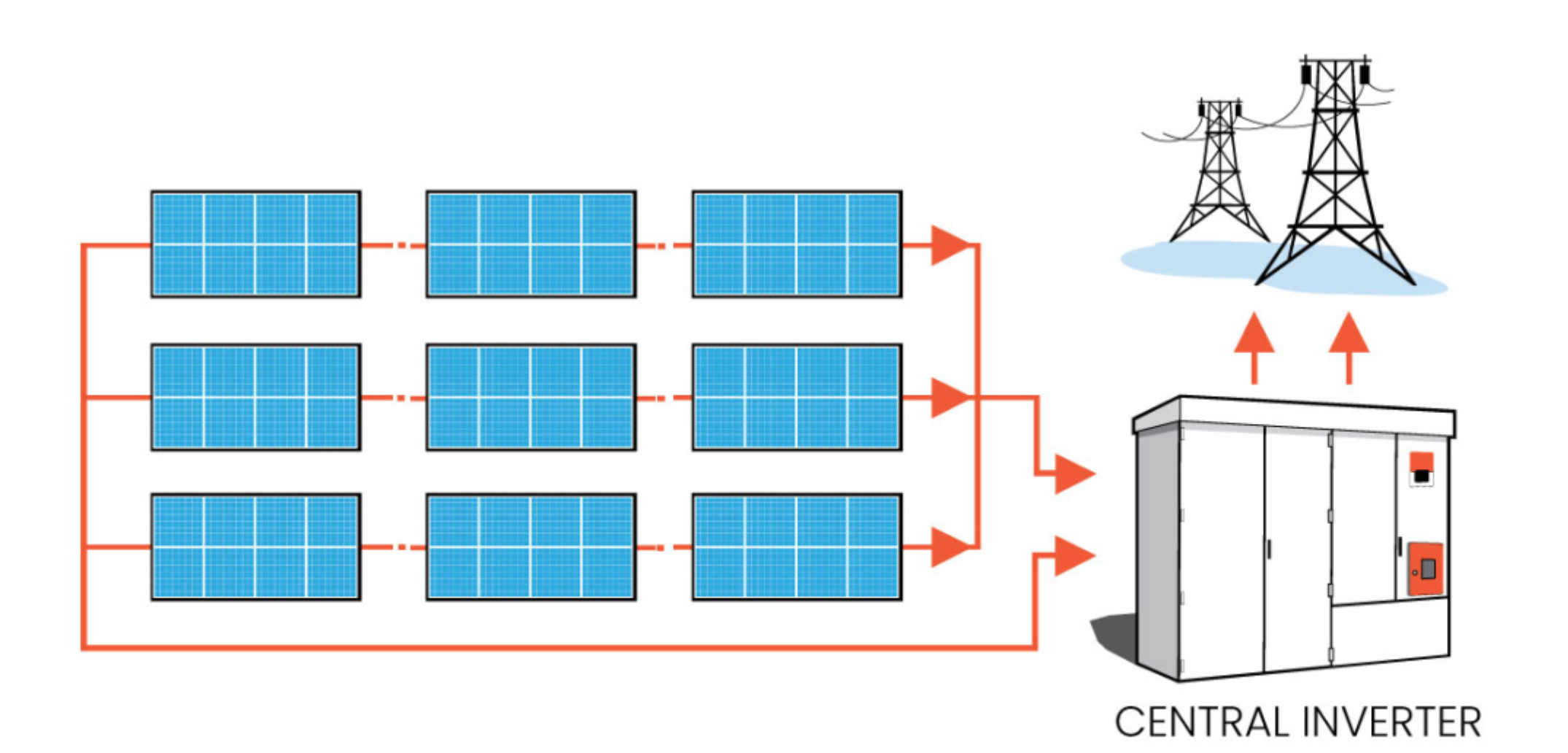
|

|
|---|---|---|
| Type | Centralized Photovoltaic Power Inverter | Distributed Photovoltaic Power Inverter |
| Different Installation Location |
Concentrated large-area photovoltaic power generation equipment is built in areas such as deserts and Gobi to make full use of abandoned land resources. The installed areas are relatively remote and desolate, and the land is relatively cheap. |
Distributed photovoltaics are usually built on building roofs, factory roofs, and vegetable sheds to make full use of the space. |
| Ease of Installation Varies | Slightly more difficult installation, and the requirements are relatively high. | Easy to install and easy to maintain. In addition, the policies of various countries generally support distributed photovoltaic power generation, so the future prospects are very good |
| Different Grid-connected Voltage Levels |
The grid-connected voltage of centralized photovoltaic power plants is usually 35KV or 110KV. If the power of the power station is less than or equal to 30 MW, there will usually not be a main transformer, and this grid that exceeds 35KV will be connected to the grid. For power stations above 30 MW, the main transformer is usually installed, and the main transformer is upgraded to a voltage level of 110KV before being connected to the grid. |
For distributed photovoltaics, the 380V voltage is usually connected to the grid, and a low-voltage release is usually used to connect to the grid, and the number of distributed grid-connected points depends on the actual situation. |
| Different Secondary Equipment Used in the Power Station |
Centralized photovoltaic station usually have their own substation due to their relatively high voltage levels. Inverters are usually located inside the substation room and are of relatively large size. The boost function is completed by replacing the box, usually up to 35KV. There are many devices in the booster station. The main equipment includes power station transformers, switch cabinets, various transformers, arc suppression coils and main transformers. Secondary equipment includes microcomputer protection devices, watt-hour meters, dispatching data screens, etc. The more complicated scheduling directly realizes the centralized management of the power station. At the same time, the station also needs a power prediction system and a power control system, which are much more complicated than distributed photovoltaic systems. |
Distributed photovoltaic power stations are low-voltage 380V grid-connected equipment, so they are rarely used for primary and secondary equipment. Among them, the inverter is usually a wall-mounted inverter, which is relatively simple to install and small in size. The transformer is also the kind of small transformer. Commonly used microcomputer protection includes power quality monitoring, anti-islanding protection devices and fault disconnection. According to regional requirements, equipment requirements and technical parameter requirements are also different. But at present, the anti-islanding protection device is a must-use device for every distributed photovoltaic. |
| Different Transmission Distance |
The electricity generated by the centralized photovoltaic power station is connected to the grid through high-voltage, and the electricity is transmitted layer by layer to a higher voltage level.
For example, China's current "West-to-East Power Transmission": transmit high-voltage power from the west to the east to realize power transmission from west to east . |
Distributed photovoltaic power generation generally means that the generated electricity is connected to the grid on the spot, with very low or no line loss, and it can also supplement local electricity for local and nearby electricity consumers. |
Get in Touch with us
to start Happier life with Green energy

- One-stop Solution
- Get Step Quote
- 24/7 Service
- Design & Installation Support
